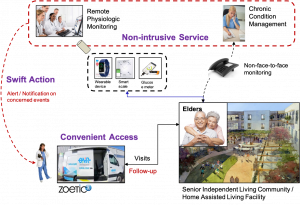Elder population is growing from 56 M in 2020 to estimated 98.2 M by 2060. On the same context, an average annual healthcare cost for an elder is 5 times as compared with the one for a working adult. From the care cost break-down, 73% is allocated to acute care while only 9% is spent on preventive care. A Watson IBM research also points out a 6:1 saving ratio between preventive and acute care. CMS (Center of Medicare and Medicaid Service) has initiated a shift from acute to preventive care with a set of initiatives, including AWV (Annual Wellness Visit), CCM (Chronic Care Management) and RPM (Remote Physiologic Monitoring).
Since 2015, CMS has gradually increased the number of CPT codes for preventive care services and improve the flexibility for preventive care delivery. As an example, total monthly time spent for CCM patients can count clinical staff as well as physician time. Recently, CMS has changed the clinical staff from direct to general supervision, opening doors for physicians to have its preventive care staff being remotely located.
Even with all the commitments, preventive care services have not gained traction as planned. The challenges include the disruption of existing practices’ workflow to implement non-face-to-face engagements, the patient outreach activities to register elders for preventive care service and the communication on preventive care benefits in term of quality-of-life improvements.
Zoeticx and its strategic partners introduce Integrated Healthcare Platform to address the above challenges. Integrated Healthcare Platform focuses on delivery quality care to elders population and is based on three major concepts:
- Convenient medical access: Medical access supported in senior living communities and home assisted living facilities is mostly supported by transportation services to medical centers. Mobile care units, staffed with care providers, can achieve the upmost convenient medical access to elders living in senior living communities and home assisted living facilities. With the mobile care units, medical staff can provide both practice services as well as register elders for preventive care services.
- Non-intrusive preventive care services: Monitoring chronic conditions and physiologic measurements must be as non-intrusive as possible to elders. IT infrastructure must be seamless to elders. Telemedicine must include the ability to perform measurements, extract data seamlessly daily as well as telehealth capabilities to perform regular check-up without requiring the elders at the practice.
- Swift follow-up actions: Preventive care services must support anticipation on concerned medical conditions. Reaching out to patient can be supported by clinical staff from mobile care unit or providers at the medical center. The whole concept of reducing the overall care cost is based on timely anticipation of patient medical conditions.
The following figure illustrates the whole concept for Integrated Healthcare Platform.


